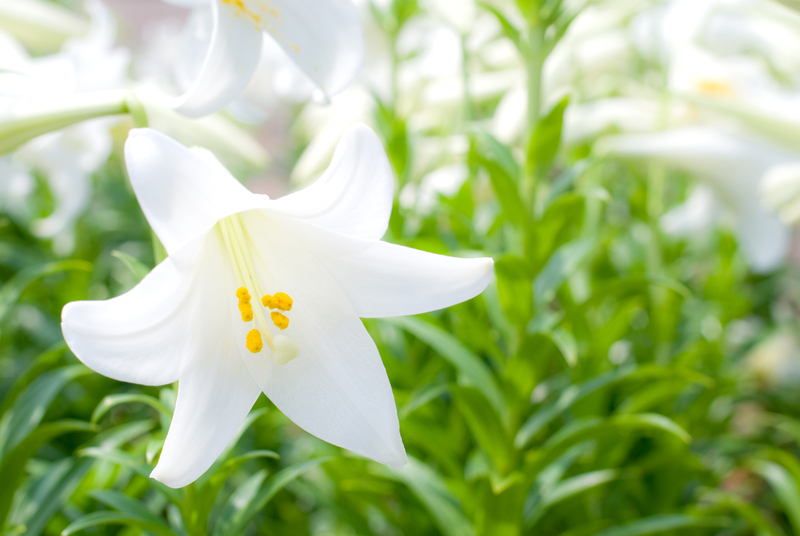Spring is an exhilarating time for gardeners, and in Mississippi the little flowers do not necessarily peep through the ground as the Sunday school song would have us believe. They burst forth with a profusion of blossoms, color, and fragrance. And for gardeners who celebrate Easter, the timing is just about perfect.
Easter is the first Sunday that follows the first full moon after the vernal equinox, so Easter can fall anywhere between March 22 and April 25. Early or late, the springtime garden at Easter will be at its loveliest.
For people of all faiths, spring is a time of hope and renewal, and flowers take on new meaning this time of year. Flowers symbolize many ancient creeds and beliefs, but for Christians, Easter and the flora of spring have been intertwined for centuries. These flowers symbolize sacrifice, renewal, and rebirth. Flowers are supposedly nonverbal, but all who believe in the miracle of spring understand the language of flowers. Here are Easter flowers that convey the spirit of the season.
EASTER LILY
The Easter lily is probably the most popular plant associated with Easter. According to legend, it was said to have bloomed after the crucifixion, and the large trumpet-shaped flowers supposedly represent the trumpets of God. Emerging from a homely, scaly bulb beneath the dirt, this plant—with its handsome green foliage and large, fragrant flowers—brings to mind the resurrection. The Easter lily is a symbol of hope.
Actually, the Easter lily, Lilium longiflorum, which we associate with Easter, does not grow in the Middle East but is native to islands off the coast of Japan. Prior to World War II they were imported, but today, almost all Easter lilies are grown in a small area along the coast of California and Oregon where the climate is ideally suited for these particular lilies. Regardless of where the lilies originated, the symbolism is truly meaningful, and many churches fill their sanctuaries with these lilies.

CROSS VINE
It is almost a natural impulse to pull vines away from trees, but before doing so, remember that there are some vines that are really quite harmless and sport beautiful flowers. One such native vine is cross vine, Bignonia capreolata. This vine has red-orange tubular flowers with yellow centers and blooms in early spring. These flowers bloom at just the right time for migrating hummingbirds and are a valuable source of nectar.
Cultivars of this native vine that produce copious flowers can be found at local garden centers or ordered from garden catalogs. This vine is perfect for arbors, trellises, or pergolas. If a cross-section is made of the stem of this vine, a perfect little cross will be revealed in the pith, which explains its common name. Look for this vine to bloom during Holy Week.

PASSION VINE
Passion vines, locally called maypop vines, probably have more Christian symbolism than any other plant.
In Mississippi, there are two native species, Passiflora incarnata and Passiflora lutea. The “passion” in the name comes from the passion or crucifixion of Jesus. Spanish missionaries to the New World used this unusual flower to tell the story of Easter. The halberd-shaped leaves represent the sword that pierced Jesus’ side, and the radial filaments symbolize the crown of thorns. The three stigmas represent the nails. The five anthers represent the five wounds.
This lovely wildflower is sometimes thought to be a bit weedy, but the flowers are gorgeous, exotic, and like no other flower in the area. As an added plus, this vine is the host plant for the Gulf Fritillary butterfly. The Spanish missionaries were quite taken with this wildflower with a story to tell and saw its possibilities, and we should also.

DOGWOOD
One of the most beautiful trees to adorn the woods of Mississippi is the native dogwood, Cornus florida. This tree, of course, is not native to the Holy Land, but it became a symbol of Easter, primarily because of the popular poem “The Legend of the Dogwood.” According to tradition, the dogwood was once a mighty tree and was used to make the cross on which Christ was crucified. After the crucifixion, the dogwood tree was transformed into a small, flowering tree that could never be used as a cross again. The author of the poem is unknown, but every Easter it is read, and the legend lives on.
The dogwood tree has much symbolism. The bloom has four petals (bracts) in the shape of a cross. The end of each petal has a rust stain, which is indicative of the “blood shed for thee.” The green center of the blossom represents the crown of thorns.
Dogwood trees frequently bloom at Eastertime, and the branches are sometimes used in flower arrangements. However, dogwood trees are not as prolific as they once were, and this practice should be somewhat discouraged, unless one has a veritable copse filled with dogwood trees.
Dogwood trees have been plagued by anthracnose, a fungus, and they have disappeared from many areas. Today there are hybrids that are more resistant to the disease, but they are not as lovely and graceful as the Mississippi native, Cornus florida. Two cultivars of Cornus florida that are resistant to anthracnose to try are Appalachian Spring and Cherokee Princess. Please keep planting this symbol of Easter, as the dogwood is a native Mississippi tree.





